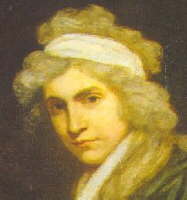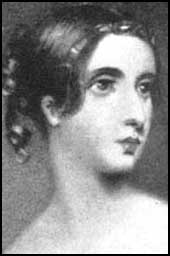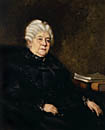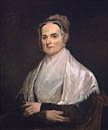
"Reviled in her day as a 'hyena in petticoats', Mary
Wollstonecraft (1759-1797) is now recognized as one of the mothers of British and American
feminism. In her most famous work, Vindication of the Rights of Woman, which
was published in 1792 in the immediate aftermath of the French Revolution,
Wollstonecraft applies radical principles of liberty and equality to sexual
politics. Rights of Woman is a devastating critique of the 'false system of
education' which she argues forced the middle-class women of her time to live
within a stifling ideal of femininity: 'Taught from infancy that beauty is
women's sceptre, the mind shapes itself to the body, and roaming round its
gilt cage seeks only to adore its prison'. Instead, Wollenstonecraft dares to
address women as 'rational creatures', and she urges them to aspire to a wider
human ideal which combines feeling with reason and the right to independence
A self-taught native of London, Mary Wollstonecraft worked as a
schoolteacher and headmistress at a school she established at Newington Green
with her sister Eliza. The sisters soon became convinced that the young women
they tried to teach had already been effectively enslaved by their social
training in subordination to men. In Thoughts on the Education of
Daughters (1787) Wollstonecraft proposed the deliberate extrapolation
of Enlightenment
ideals to include education for women, whose rational natures are no less
capable of intellectual achievement than are those of men.
Following a period of service as a governess to Lord Kingsborough in
Ireland, Wollstonecraft spent several years observing political and social
developments in France, and wrote History and Moral View of the Origins
and Progress of the French Revolution (1793). Her A Vindication
of the Rights of Men (1790) is a spirited defense of the ideals of the
Revolution against the conservative objections of
. Upon her
return to England, she joined a radical group whose membership included Blake,
Paine, Fuseli, and
Wordsworth. Her first child, Fanny, was born in 1795, the daughter of American
Gilbert Imlay. After his desertion, she joined the radical activist
William Godwin,
a long-time friend whom she married in 1797. Wollstonecraft died a few days
after the birth of their daughter, Mary (who later married Percy Blyth
Shelley and wrote
Frankenstein, or The Modern Prometheus and other novels).
 John Stuart
Mill, the eldest son of the philosopher,
James Mill, was
born in London
on 20th May, 1806. Educated a home by his father, John Stuart had studied the
works of Aristotle, Hobbes, Plato,
Jeremy Bentham,
Ricardo and Adam Smith by the time he had reached the age of twelve.
John Stuart
Mill, the eldest son of the philosopher,
James Mill, was
born in London
on 20th May, 1806. Educated a home by his father, John Stuart had studied the
works of Aristotle, Hobbes, Plato,
Jeremy Bentham,
Ricardo and Adam Smith by the time he had reached the age of twelve.
Mill was especially impressed by the work of
Jeremy Bentham.
He agreed with Bentham when he argued in I
Mill also began having articles published in the Westminster
Review, a journal founded by
Jeremy Bentham
and James Mill to propagate Radical views.
Jeremy took an active role in the campaign for parliamentary reform, and was one
of the first to suggest that women should have the same political rights as men.
 In 1833
Mill became a close friend of
Harriet Taylor (1831-1907). The two worked closely together but Harriet was married
and her husband, John Taylor, was unwilling to give her a divorce. After the
death of John Taylor in 1849, Harriet married John Stuart Mill (1851). A few
months after the wedding the
Westminster Review published The
Enfranchisement of Women. Although the article had been mainly
written by Taylor, it appeared under John Stuart Mill's name. The same
happened with the publication of an article in the Morning
Chronicle (28th August, 1851) where they advocated new laws to
protect women from violent husbands. John and Harriet leased a house in Blackheath
Park; with them was Taylor's nineteen-year-old daughter, Helen. From this secluded house emanated some of the most
powerful and influential writings ever penned to promote women's equality,
and it was to this household that the Victorian women's movement in England
came to look for leadership, guidance, and money.
In 1833
Mill became a close friend of
Harriet Taylor (1831-1907). The two worked closely together but Harriet was married
and her husband, John Taylor, was unwilling to give her a divorce. After the
death of John Taylor in 1849, Harriet married John Stuart Mill (1851). A few
months after the wedding the
Westminster Review published The
Enfranchisement of Women. Although the article had been mainly
written by Taylor, it appeared under John Stuart Mill's name. The same
happened with the publication of an article in the Morning
Chronicle (28th August, 1851) where they advocated new laws to
protect women from violent husbands. John and Harriet leased a house in Blackheath
Park; with them was Taylor's nineteen-year-old daughter, Helen. From this secluded house emanated some of the most
powerful and influential writings ever penned to promote women's equality,
and it was to this household that the Victorian women's movement in England
came to look for leadership, guidance, and money.
Mill was the most prestigious radical writer in England
and his the most prestigious name to be associated with the cause of women's
social and political advancement. Although the nature of the influence of
his wife and stepdaughter may be a matter of controversy both then and now,
there is no doubt that in Mill's own mind and for most of their
contemporaries all three were contributors to the cause.
The Seneca Falls Convention, held in Seneca Falls, New York, on July 19-20, 1848, was the first public political meeting in the United States dealing with women's rights. It issued the "Seneca Falls Declaration of Sentiments" (modeled on the Declaration of Independence), enumerating the ways in which men had oppressed American women, including depriving them of the vote, of equal property rights, of equal access to employment and education—in short, of the full rights and privileges of citizens. The "Resolutions," which accompanied the "Declaration of Sentiments," were unanimously approved, except for one demanding the vote. Some participants felt this demand was too extreme; others believed women should avoid being drawn into politics. The suffrage plank did pass, but by a narrow majority.

 The
Seneca Falls Convention was organized by Lucretia Mott and Elizabeth Cady
Stanton, two Quakers whose concern for women's rights was heightened when
Mott, as a woman, was denied a seat at an international antislavery meeting in
London. In 1848, at Stanton's home near Seneca Falls, the two women, working
with Martha Wright (Mott's sister), Mary Ann McClintock, and Jane Hunt, sent
out a call for a women's conference to be held a week later at the Wesleyan
Chapel in Seneca Falls. The meeting attracted 240 people,
including—unexpectedly—40 men (among them, Frederick Douglass, the ex-slave
abolitionist). Daunted by the size of the gathering, the organizers persuaded
Mott's husband, James, to chair the meeting. In spite of the men's
participation, however, the resolutions approved at the meeting explicitly
blamed men for the injustices women were suffering and made clear that women
must rely on themselves to achieve their emancipation.
The
Seneca Falls Convention was organized by Lucretia Mott and Elizabeth Cady
Stanton, two Quakers whose concern for women's rights was heightened when
Mott, as a woman, was denied a seat at an international antislavery meeting in
London. In 1848, at Stanton's home near Seneca Falls, the two women, working
with Martha Wright (Mott's sister), Mary Ann McClintock, and Jane Hunt, sent
out a call for a women's conference to be held a week later at the Wesleyan
Chapel in Seneca Falls. The meeting attracted 240 people,
including—unexpectedly—40 men (among them, Frederick Douglass, the ex-slave
abolitionist). Daunted by the size of the gathering, the organizers persuaded
Mott's husband, James, to chair the meeting. In spite of the men's
participation, however, the resolutions approved at the meeting explicitly
blamed men for the injustices women were suffering and made clear that women
must rely on themselves to achieve their emancipation.
 Mary McLeod Bethune
(1875-1955) , born to
former slaves a decade after the end of the Civil
War, devoted her life to ensuring the right to
education and freedom from discrimination for
black Americans. Bethune believed that through
education, blacks could begin to earn a living in
a country that still opposed racial equality.
Bethune worked tirelessly until her death and
would not rest while there was "a single Negro boy
or girl without a chance to prove his worth."
Mary McLeod Bethune
(1875-1955) , born to
former slaves a decade after the end of the Civil
War, devoted her life to ensuring the right to
education and freedom from discrimination for
black Americans. Bethune believed that through
education, blacks could begin to earn a living in
a country that still opposed racial equality.
Bethune worked tirelessly until her death and
would not rest while there was "a single Negro boy
or girl without a chance to prove his worth."
As a young teacher in Chicago, she visited
prisoners in jail, giving them inspiration through
song. She worked at the Pacific Garden Mission,
serving lunch to the homeless, and counseled the
residents of Chicago's slums. In Florida, she
organized a Sunday school program and sang to
prisoners.
In 1904, Bethune opened the Daytona Normal and Industrial
Institute for Negro Girls. The school opened with five girls as students and
later accepted boys as well. Tuition was 50 cents a week, but Bethune never
refused to educate a child whose parents could not afford the payment.
With her school a success, Bethune became
increasingly involved in political issues. It was
through her discussions with Vice President Thomas
Marshall that the Red Cross decided to integrate,
and blacks were allowed to perform the same duties
as whites. In 1917, she became president of the
Florida Federation of Colored Women. In 1924,
Bethune became president of the National
Association of Colored Women, at that time the
highest national office a black woman could
aspire. And in 1935, she formed the National
Council of Negro Women to take on the major
national issues affecting blacks.
Bethune served as director of the National
Youth Administration's Division of Negro Affairs
(1936), Vice-President of the NAACP (1940), and
served on President Truman's Committee of Twelve
for National Defense (1951). She also continued
working with many organizations, such as the
National Urban League, the Association of American
Colleges, and the League of Women Voters.
 Betty (Goldstein) Friedan (1921-2006) graduated from Smith College in 1942
and worked for five years before marrying Carl Friedan
(divorced 1969) and settling uncomfortably into the
life of a housewife, mother, and occasional freelance writer.
Discovering in 1957 that several of her college
classmates were as dissatisfied with their lives as
she was with her own, she began a series of studies
that eventually resulted in the landmark work
The
Feminine Mystique (1963). The book's thesis was
that women were victims of a pervasive system of
delusions and false values that urged them to find
their fulfillment and identity vicariously, through
their husbands and children. An immediate and
controversial best-seller, it is now regarded as one
of the most influential American books of the 20th
century.
Betty (Goldstein) Friedan (1921-2006) graduated from Smith College in 1942
and worked for five years before marrying Carl Friedan
(divorced 1969) and settling uncomfortably into the
life of a housewife, mother, and occasional freelance writer.
Discovering in 1957 that several of her college
classmates were as dissatisfied with their lives as
she was with her own, she began a series of studies
that eventually resulted in the landmark work
The
Feminine Mystique (1963). The book's thesis was
that women were victims of a pervasive system of
delusions and false values that urged them to find
their fulfillment and identity vicariously, through
their husbands and children. An immediate and
controversial best-seller, it is now regarded as one
of the most influential American books of the 20th
century.
In 1966 Friedan co-founded the National Organization
for Women (NOW), which was dedicated to achieving
equality of opportunity for women. A founding member
of the National Women's Political Caucus (1971), she
was a leader of the campaign for ratification of the Equal Rights Amendment. The
Second Stage (1981) assessed the status of the
women's movement. The Fountain of Age (1993)
addresses the psychology of old age, seeking to
counter the notion that aging means loss and
depletion. Her memoir, Life So Far, appeared in
2000.